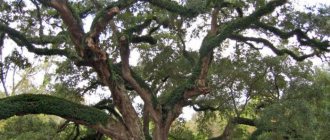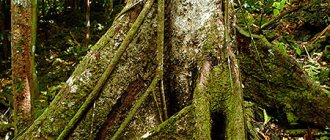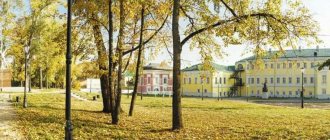Even children know this, that you can determine the age of a tree simply by counting the rings on the cross section. These rings are formed as a result of uneven growth at different times of the year. In the warm season (summer), wood grows faster and a less dense and lighter layer is formed than in transition periods (spring and autumn).
But in the tropics, only a very few tree species, such as teak, have visible rings: for most trees, the transition between wet and dry seasons is too rapid for changes in wood density to become apparent. Or the climate is constant and the tree grows all year round.
Baobab
The main example given first of a tree without finished rings is the baobab . This long-lived tree (life expectancy can be 2-3 thousand years and reach 4-5 thousand) has no annual rings and there are soft, porous tissues under the thick bark.
Hevea
Another, no less famous tree is the Hevea or “ rubber tree ”. Hevea wood has a weak texture due to the absence of annual rings.
Welwitschia stands out separately - this is an unusual dwarf tree, which was discovered by the German botanist Friedrich Welwitsch at the end of the 19th century. Its low and thick trunk grows mainly in width and is almost completely hidden in the ground. The dark brown substance of the trunk does not have annual rings, but it is dense and hard, like that of a sequoia.
Velvichia
How to determine age?
It is not determined out of curiosity. Often this is a necessary procedure in cases where a decision is made to cut down or carry out vaccination procedures.
There are various ways:
- in coniferous trees, whorls (fan-shaped shoots on the trunk) are counted. Years are added to the resulting value: for spruce 7mdash; 3, for fir - 5, for cedar - 10;
- Knowing the average annual growth of a certain type of green space in your area, you need to measure the circumference of the trunk at 1.3 meters from the ground, calculate the diameter and divide it by the growth factor.
A more accurate way is to count the annual rings inside the trunk.
The oldest giant trees
Scientists have always been sure that the tallest trees with wide, immense trunks are the longest-livers. After all, the annual rings of wood increase the thickness of the trunk more and more over time. Therefore, sequoias and sequoiadendrons, the great giant trees growing in North America, were considered the most ancient for quite a long time. The giant trunk of a sequoia can reach one hundred meters, and its diameter is about 8.5 meters. You can easily build a small cozy house on the stump of this tree. There is also a known case when, in the place of a huge hollow of a giant tree giant, a tunnel 8.7 m long, 3 m high and 2.5 m wide was laid. Among these giants, a sequoia was discovered, which at that time was more than 2125 years old. For a very long time this tree was considered the most ancient on the planet.
But in the middle of the 20th century, for the purpose of scientific research, they cut down the ancient bristlecone intermontane pine, which turned out to be more than 4900 years old! Experts could not even imagine that the pine tree was about 5 thousand years old, because its height was no more than 10 meters. Of course, they regretted what they had done, but it was thanks to this incident that it became clear that the size of a tree does not always correspond to its age. The study of other long-lived pines is now treated more carefully and carefully, using the most modern methods and technologies for research. There were many such long-lived pines and each of them was given its own name. The annual map of this unique ancient woody plant is distinguished by its extraordinary density and is therefore not visible to the naked eye. It grows very slowly and increases in diameter by only 2.5 cm over 100 years. Today, these pines are considered the most ancient on our planet. But who knows what will happen in another 50 or 100 years. Perhaps other scientists will be able to find trees even older than these.
Definition
Tree rings, or annual layers, are areas of cyclical tissue growth in plants and some other species of living beings, for example, mushrooms and mollusks. Their appearance is due to climatic temperature changes and some other factors. Now we know what a growth ring is.
But the most characteristic and pronounced annual rings are observed in perennial woody plants. Especially those that grow in the temperate latitude zone, when periods of summer-spring growth of the cambium alternate with dormancy in the autumn-winter part of the year. If we talk about the appearance of the rings, then each of them is divided into two parts: dark and light. Coniferous trees are interesting because their growth rings are most clearly visible, since the wood that formed later has a pronounced dark shade. Now we know what a growth ring is. They are studied by a science such as dendrochronology.
Animal world
As already mentioned, growth rings are found not only in trees, but also in the animal world. They can be found in those tissues or skeletal structures that grow continuously, but are subject to climatic influences and seasonal temperature changes. These are scales, bones and fins of some types of fish, shells of various types of mollusks, beaks and bones of birds, horns of animals, bones of some mammals. So now we know what tree rings are in biology. From them, scientists determine everything the same as in the case of trees: age, climate characteristics of that period, etc.
Preview:
Autonomous educational institution gymnasium No. 9, Moscow region, Korolev
RESEARCH
On this topic:
"LORD OF THE RINGS"
“Blessed is he who clearly sees
At least a shell of nature"
One thing we might ask ourselves is whether we have really made any progress in understanding past climates through trees. Well, the answer is yes. It is true that climate reconstructions have been made from other proxies, but trees were a fundamental element to better understand the temperature evolution of the last millennium, as they were, for example, the basis for the first temperature reconstructions for this period. Thanks to trees, other proxies and climate models, we now know much better how the climate of the last millennium was.
Johann Goethe
Fundamental question:
What secrets do tree rings hide?
Goals of work:
- Collect information on the topic and analyze it.
- Systematize the material.
- Highlight the main facts and draw conclusions.
- Prepare material and prepare presentation.
Research objectives:
Yes, the average temperature of those centuries was relatively lower than today, as evidenced by the reconstruction of summer temperatures for Germany in the figure. A similar cooling occurred in the rest of Europe. For example, in England the temperature was so low that the waters of the River Thames often froze, so people rode on it, as can be seen in some paintings of the time.
Dedclimatology or climate in memories of trees
The trees also tell us that before, during the Middle Ages, the climate was probably warmer than during the minor ice age. However, it is not yet clear if the current temperature is higher than the temperature of the medieval warm period.
Climate Changes and Projections
Russian dendrochronologists O. A. Pomortsev, E. P. Kashkarov, N. V. Lovelius used bristlecone pine data to restore the temperature regime over 7000 years and found that weather anomalies repeat with a certain periodicity. They identified a 2600-year rhythm with characteristic climate changes: first, there is a decrease in heat and moisture, then an increase in cold and dryness, and, finally, a new wave of increase in humidity under the dominance of cold conditions. In a 2015 article, they gave a forecast for the future: “Ahead of us lies a protracted “watery” period with the dominance of typhoons, floods and mild winters. It will stretch for 800 years and will alternate with secular waves of warming and cooling at the boundaries and within centuries. The greatest warming of the Arctic in the current 2600-year rhythm can be expected around the year 2200. It will be smaller than the modern one, but the level of the Caspian Sea will remain at the -28-meter mark. The “water” period will end with a sharp cooling of the Arctic between 2500–2600 and an increase in the level of the Caspian Sea to –27–26 m.” They noted that the 2,600-year rhythm beats out on the Ferguson scale with mathematical precision.
Previously, the founder of the scientific school of dendroindication of natural processes and anthropogenic influences, Doctor of Biological Sciences Nikolai Lovelius, spoke to the Science channel about methods of working with tree rings.
Text: Evgenia Shmeleva











